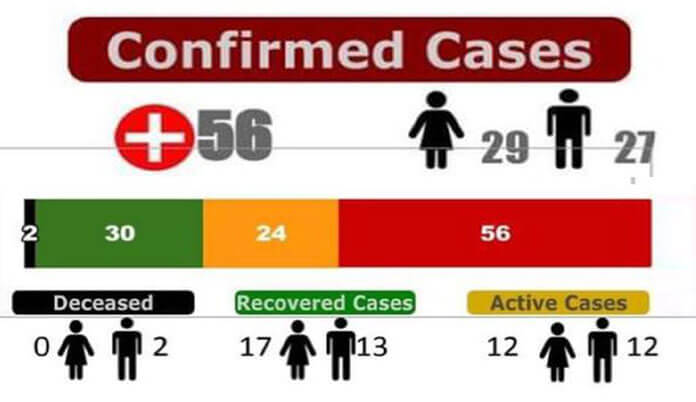BELIZE CITY, Tues. Nov. 17, 2020– Recent data released on the CARICOM COVID-19 dashboard ranks Belize as the country with the 2nd highest number of active COVID-19 infections when compared to 20 other CARICOM nations.
Jamaica has the highest number of active cases recorded to date, 4,258. Belize currently has 2,181 active cases as of November 16, 2020. These staggering numbers are a far cry from where we were just months ago, when we had the 2nd lowest number of confirmed cases across the Caribbean.
Where did we go wrong?
A State of Emergency was declared in March when the index case was identified in San Pedro. The State of Emergency remained in effect until July 1, with a total lockdown being implemented in April and a phased relaxation of emergency measures being implemented in May.
By July 1, five months into the pandemic, only 48 cases were recorded in Belize.
On April 1, 2020, we had only 3 active cases in-country, and the nation was under a total lockdown. This measure achieved its objective of reducing the spread of the virus, since only 15 new cases were identified during that month.
Belize was a superstar on the international COVID-19 response scene. A government response tracker tool created by the University of Oxford’s Blavatnik School of Government even ranked Belize among the top 10 countries most prepared to lift physical distancing measures.
The COVID-19 timeline for Belize shows the first upward trend in cases beginning to occur in August 2020. Coincidentally, in that same month the Barrow administration decided to carry out a phased reopening of the country.
This was put off when cases started to show up in the triple digits. As mentioned, we ended the month of July with 48 confirmed cases; 16 were active at that time, and two deaths were recorded.
One month later, by August 31, 1,007 cases were confirmed; 821 of them were active cases and the death toll jumped to 13. The epidemiological curve had begun its violent climb.
At the time, Dr. Marvin Manzanero had pointed out that the younger population, persons between the ages of 20 and 34, would make up the majority of cases. He said that these younger persons who engage in more social interaction and are active in the workplace may not present symptoms, but may be carriers and spreaders of the virus, further expanding the curve.
In September, a number of parties and social gatherings were reported as citizens celebrated the Battle of St. George’s Caye and the anniversary of our Independence. The Director of Health Services warned citizens to continue to adhere to the COVID-19 protocols, but his cries fell on deaf ears. About 942 new infections were reported in the month of September.
A lackadaisical attitude towards the prevention protocols began to take hold of the Belizean population. After months of lockdown and movement restrictions, persons were eager to return to public life, in every way, some for work, others for pleasure; either way, the result of this negligent behavior could be seen in the number of cases and deaths reported in the month of October. A total of 32 deaths were recorded, and 1,585 new cases were recorded in that month.
A frightening surge of new cases was recorded in the Orange Walk District; the jurisdiction remains the country’s COVID-19 epicenter.
Despite strict legislation put in place to prevent illicit trans-border commerce, border jumpers from the northern districts were still blamed for the alarming numbers in those areas.
The Philip Goldson International Airport (PGIA) was also reopened on October 1, under strict screening protocols. Travelers must enter the country with a certified result of a PCR test that had to have been taken no more than two weeks prior to arrival, or be subjected to a test at the airport facility before entering the country.
Persons with a positive test result would be placed under a mandatory quarantine.
Initially, all persons arriving at the PGIA were instructed to go into quarantine, but former Prime Minister Dean Barrow and the now-disbanded National Oversight Committee decided to relax this measure, allowing all persons with a negative test result, even those who were possibly asymptomatic carriers, to roam freely across Belize.
At the time, Barrow commented that Belizean citizens posed a higher risk to travelers entering the country than those travelers did to the population.
Nightmarish numbers continue to be recorded in the month of November. Since the start of the month, 1,306 new confirmed cases have been recorded. A total of 94 deaths are now confirmed — 35 new deaths in just 16 days. On Friday, November 13, 10 deaths were recorded, and 2,181 cases remain active.
The Office of the Director of Health Services and the Ministry of Health have engaged in a vigorous education campaign via all media outlets in Belize, including social media.
However, many in the public have apparently failed to grasp the messages echoed by officials — that preventing the spread of COVID-19 is crucial to our response as a country, and abiding by the prevention protocols in place could save many lives.
The worst-case scenario, as outlined by Dr. Marvin Manzanero, is an overwhelmed healthcare system. This means that hospitals operating at maximum capacity would have to choose which patients to provide treatment to, or in a more heartbreaking scenario, may have to deny treatment completely to visibly sick persons.
Both the citizenry and the newly elected administration will have a monumental task at hand to get control of COVID-19 in Belize. Citizens will have to actively adhere to the prevention protocols currently in place more than ever, and the Government will have to chart a path forward to halt the spiraling number of cases.
As of Monday, November 16, a total of 44,791 cases are active among CARICOM nations. Over 285,527 confirmed cases are recorded, and a total of 4,073 fatalities have been reported in this region.

